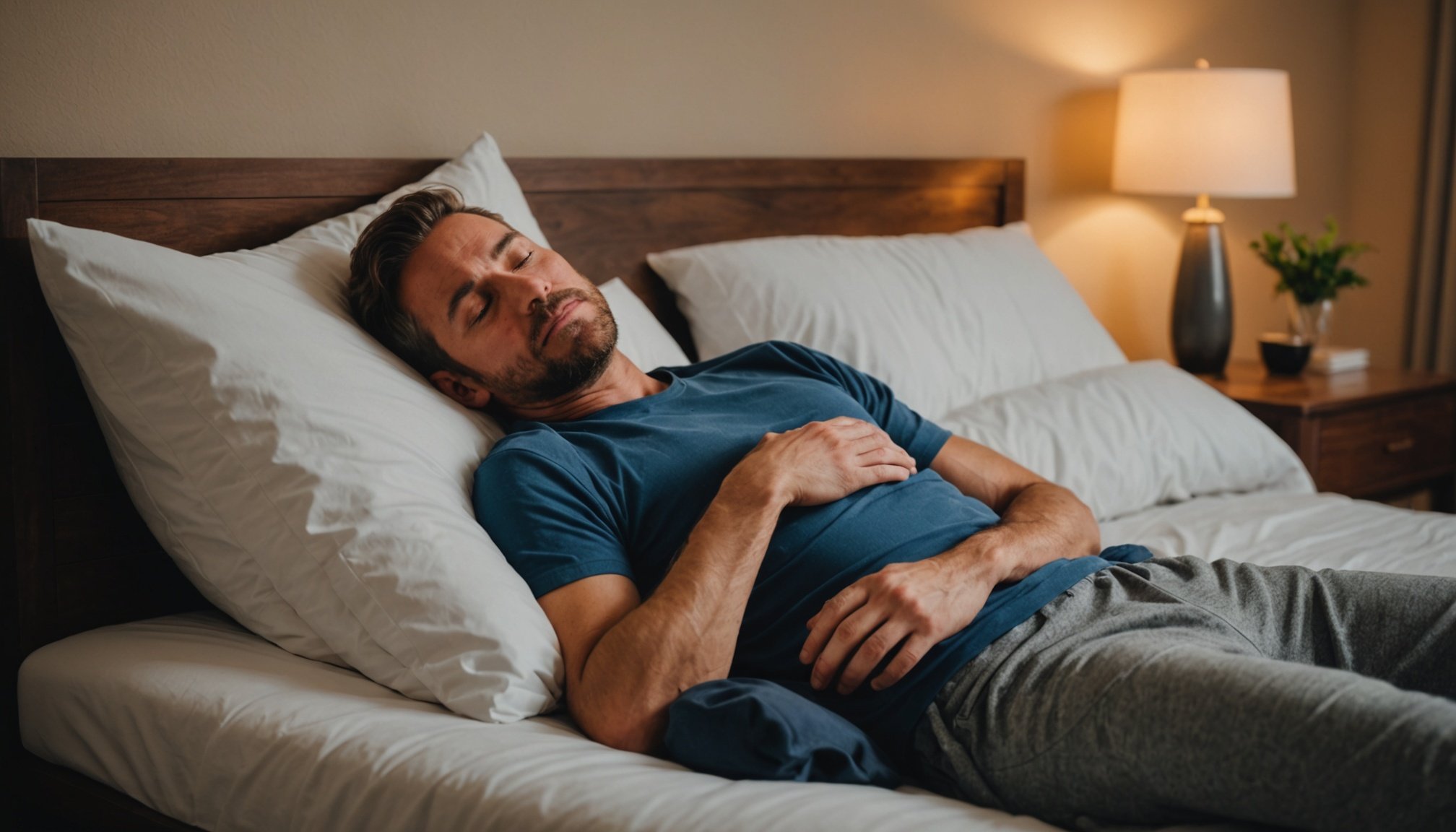Understanding Progressive Muscle Relaxation
Progressive Muscle Relaxation (PMR) is a technique developed in the 1920s by Edmund Jacobson to relieve tension and stress. It involves tensing and then slowly relaxing each muscle group in the body. This process is designed to heighten awareness of physical sensations related to stress and relaxation.
The primary application of PMR is in the management of stress-related disorders, notably insomnia relief. Individuals suffering from insomnia often experience muscle tension, which PMR aims to alleviate. By systematically relaxing the body, PMR promotes a state conducive to sleep onset and contributes to improved sleep quality.
Topic to read : Discover the Transformative Advantages of Adding Mindful Breathing to Your Everyday Life
PMR is grounded in both psychological and physiological principles. Psychologically, it aids in reducing anxiety by focusing attention on the body, hence serving as a mindful distraction from racing thoughts often associated with insomnia. Physiologically, it counteracts the fight-or-flight response, lowering heart rate and blood pressure, and inducing a relaxation response that facilitates sleep.
The practice of PMR can be easily integrated into daily routines. Regular use may foster a greater awareness of bodily tension and help individuals better control stress, leading to more effective insomnia management and an overall improvement in well-being.
In the same genre : Guidelines for Safely Incorporating Essential Oils at Home with Young Children
Step-by-Step Guide to PMR
Progressive Muscle Relaxation (PMR) is a valuable technique for easing tension and enhancing sleep improvement. It involves systematically tensing and relaxing different muscle groups to reduce stress.
Preparation for PMR
Before beginning relaxation exercises, ensure your environment encourages tranquility. Choose a quiet setting to minimise distractions. This quiet space allows for better concentration and fosters a more effective PMR experience. Comfortable clothing and a supportive position, whether sitting or lying down, further enhance the process.
The PMR Process
To execute PMR techniques effectively, follow detailed instructions for each muscle group. Begin with your feet and gradually work upwards, or vice versa. For each group, tense the muscles tightly for about five seconds, then release slowly for 15-20 seconds. This method promotes awareness of bodily sensations, helping to identify and alleviate areas of stress.
Follow-up and Reflection
Post-exercise self-assessment is crucial in PMR. Reflect on any noticeable changes in muscle tension or overall relaxation. Regular practice of PMR techniques not only aids sleep improvement but also enhances your ability to recognise stress signals. This ongoing reflection is key to integrating PMR as a sustainable relaxation strategy.
Benefits of Progressive Muscle Relaxation for Sleep
Progressive Muscle Relaxation (PMR) offers various benefits for individuals struggling with sleep issues. This technique involves gradually tensing and relaxing different muscle groups, thereby promoting overall relaxation.
One of the main benefits of PMR is its ability to reduce anxiety, a common barrier to achieving quality sleep. By concentrating on specific muscle groups, individuals can break the cycle of anxious thoughts, allowing their mind to relax. This physical process helps in easing anxiety that often disrupts sleep patterns.
Research supports PMR’s effectiveness in enhancing sleep quality. Studies show that individuals practicing PMR experience more consistent sleep and feel more refreshed upon waking. The concentrated focus on muscle relaxation resets the body’s stress response, creating a calming effect conducive to improved sleep quality.
Additionally, personal testimonials often highlight positive experiences with PMR. Individuals report feeling more at ease before bedtime, noting less anxiety and improved overall sleep quality. They credit PMR with reducing stress and promoting a soothing transition into sleep.
By consistently practicing PMR, individuals not only reduce anxiety but also significantly improve their sleep quality, fostering a healthier, more balanced lifestyle.
Scientific Background Supporting PMR
Progressive Muscle Relaxation (PMR) has been extensively examined in PMR research, demonstrating its positive impact on sleep. Numerous studies have linked PMR to improved sleep quality and duration. During PMR, individuals actively contract and relax each muscle group, which leads to a reduction in physical tension and stress. This physiological process enhances parasympathetic activity, promoting a state of relaxation and enabling more restorative sleep.
Sleep Science
Research within sleep science highlights that PMR can lead to increased production of relaxing neurotransmitters such as serotonin and dopamine. These neurotransmitters are crucial for sleep regulation, helping to foster deeper, more restful sleep cycles. The process of engaging both mind and body in relaxation techniques allows for greater emphasis on mindfulness, which can amplify PMR’s effectiveness.
Physiological Effects
The physiological effects of PMR are primarily focused on reducing heart rate and blood pressure. This relaxation response is essential for downregulating the stress hormone cortisol, known to interfere with sleep. By incorporating mindfulness practices, individuals can better manage stress, creating an environment conducive to relaxed and uninterrupted sleep patterns.
This multifaceted approach not only enhances the immediate benefits of PMR but also supports long-term sleep improvements through consistent practice.
Best Practices for Implementing PMR
Progressive Muscle Relaxation (PMR) is a powerful technique for easing tension and reducing stress. To maximise its benefits, consider these best practices.
Firstly, crafting a relaxation routine involves setting up an optimal environment. Choose a quiet, comfortable space devoid of interruptions. Soft lighting and gentle music can enhance the experience, making your sessions more effective.
Next, the frequency and timing of PMR sessions matter significantly. Integrating PMR into your daily practice promotes consistency and better results. Aim for at least 20 minutes per session, ideally twice a day. Morning sessions can set a calming tone for your day, while evening sessions aid in unwinding before bedtime.
To seamlessly incorporate PMR into your daily life, consider aligning it with existing routines. Could you pair it with your morning coffee or evening routine? This daily practice not only makes it more manageable but ingrains it as an essential part of your schedule.
Remember to be patient with progress, as benefits with PMR tips become more evident over time. By creating a conducive environment, maintaining regular sessions, and weaving it into your routines, you’re setting yourself up for a more relaxing and balanced life.
Common Pitfalls and How to Avoid Them
Navigating Project Management Review (PMR) can be daunting, especially with misconceptions surrounding its practice. Engaging in PMR requires clarity and commitment to avoid common pitfalls. One prevalent misconception is considering PMR as merely a formality, rather than a strategic tool for continuous improvement. This misunderstanding often leads to minimal engagement, reducing its effectiveness significantly.
A frequent mistake involves neglecting to update PMR plans promptly. This oversight can create a disconnect between project objectives and outcomes, potentially leading to costly oversight. Regularly reviewing and refining these plans to reflect current project needs is crucial. Not only does this practice enhance decision-making but also prevents avoidable errors.
To commit effectively to PMR, setting a regular schedule rooted in consistent time intervals can cultivate discipline. Treating PMR sessions with the same importance as milestone meetings ensures ongoing focus. Additionally, actively involving team members in these sessions can foster a sense of shared responsibility and collective problem-solving.
By adopting these effective practices, practitioners can convert challenges into opportunities, thereby maximizing the benefits of PMR. Recognizing these pitfalls and embracing solutions ensures that PMR remains a valuable component in the project management landscape.
Additional Resources for Enhanced Practice
To elevate your experience with Progressive Muscle Relaxation (PMR) and ensure a comprehensive understanding, several PMR resources are available. These encompass audio guides, video demonstrations, and additional reading materials.
Audio and Video Resources
Leverage specialized audio guides designed to walk you through the PMR process step-by-step. Platforms like YouTube host innumerable video demonstrations featuring professionals who demonstrate PMR techniques. These visual aids can significantly enhance comprehension and execution of PMR exercises, especially for beginners.
Reading Materials
Diving into books dedicated to PMR can provide you with a more in-depth understanding. Such literature often includes scientific discussion, which can be beneficial for those curious about the underlying principles. Articles in wellness magazines or educational websites are more concise yet valuable resources to keep you updated with any developments in PMR methodology.
Online Communities
Engagement with online communities and forums is another excellent way to enrich your experience. These platforms enable sharing experiences, troubleshooting common concerns, and exchanging tips with fellow practitioners. Being part of a supportive community can provide motivation, especially when your journey encounters challenges. Engaging with others fosters both learning and encouragement, reinforcing your PMR practice effectively.
Understanding Progressive Muscle Relaxation
Progressive Muscle Relaxation (PMR) is a therapeutic technique developed in the early 20th century by Dr. Edmund Jacobson. It offers a solution for insomnia relief and promotes sleep improvement by reducing physical tension. The technique focuses on the systematic tensing and relaxing of different muscle groups. By concentrating on this process, individuals become more aware of bodily sensations, leading to a deeply relaxed state.
PMR proves beneficial in enhancing sleep quality. Many people struggle with insomnia due to heightened stress or anxiety, which keeps their bodies in a state of alertness. By employing PMR, individuals can reduce this muscular tension, signalling their body to enter a more restful phase. By focusing on incrementally relaxing the muscles, the heart rate decreases, and breathing becomes more regular, which are essential components for preparing the body for sleep.
In terms of addressing insomnia symptoms directly, PMR encourages the mind to shift away from racing or intrusive thoughts. This diversion is crucial as it dampens hyperactivity in the nervous system. Those experiencing sleep disturbances find comfort in PMR’s approach, as it empowers individuals with a tangible skill to enhance their overall well-being.
Step-by-Step Guide to Practicing PMR
Progressive Muscle Relaxation (PMR) is a powerful tool to help reduce stress and promote better sleep. This guide illustrates the essential PMR techniques, offering a structured approach to incorporating relaxation methods effectively.
Preparation for PMR Practice
Setting the right environment is crucial for effective PMR practice. Choose a comfortable and quiet location free from distractions. The room should be dimly lit, aiding in generating a tranquil atmosphere. It’s beneficial to wear loose clothing, which assists in achieving a more relaxed state. Aim to practice at a consistent time daily, perhaps incorporating it into your sleep techniques routine to optimize relaxation.
Detailed PMR Technique Steps
Begin your PMR practice by engaging specific muscle groups starting from your toes and working upwards. Focus on one group at a time, tense the muscles, hold the tension for a few seconds, then release. This tense and release exercise should be repeated for each group, allowing time to notice the change between tension and relaxation. Be mindful of your body’s response, adjusting pressure to avoid discomfort.
Incorporating Breathing Exercises
To enhance the benefits of PMR, incorporate synchronized breathing exercises. Start by inhaling deeply through your nose while tensing the muscle group. Exhale slowly through your mouth when releasing tension. This synchronization not only aids relaxation but can also maximize the effectiveness of your PMR practice.
The Science Behind PMR and Sleep
Progressive Muscle Relaxation (PMR) has emerged as a promising technique for enhancing sleep quality. Numerous research studies underscore PMR’s effectiveness, primarily through the induction of the relaxation response. This physiological reaction triggers a decrease in heart rate and muscle tension, which is crucial for achieving restorative sleep.
Scientific insights into the relationship between sleep science and relaxation response reveal noteworthy implications. When the body enters a state of relaxation, it facilitates smoother transitions into various sleep cycles, including the crucial deep sleep phase. As a result, individuals experience more restful and uninterrupted sleep patterns, highlighting the physiological benefits of PMR on sleep.
Several experts also advocate incorporating PMR for those grappling with insomnia. They suggest that by integrating PMR into nightly routines, individuals can mitigate the hyperarousal often linked to insomnia. This approach aligns with the growing body of evidence supporting PMR’s role in not just improving sleep quality, but also in addressing sleep disorders.
In conclusion, the science behind PMR and sleep underscores its effectiveness in enhancing sleep quality through physiological relaxation, corroborated by both research findings and expert opinions.
Integrating PMR into Your Nightly Routine
Progressive Muscle Relaxation (PMR) can be an invaluable addition to your nightly routine, enhancing your sleep habits for better rest and relaxation. Integrating this practice effectively, however, requires a thoughtful approach.
Creating a Relaxation Ritual
Establishing a soothing pre-sleep routine with PMR centers on creating a relaxation ritual that aligns with your lifestyle. Begin by selecting a quiet environment free from distractions; this enhances your ability to focus on the gradual tensing and relaxing of different muscle groups.
Setting a Consistent Schedule
A consistent sleep schedule amplifies the effectiveness of PMR integration. Aim to practice PMR at the same time each evening, ideally as you wind down before bed. This consistency trains your body and mind to associate PMR with relaxation, naturally improving your sleep habits over time.
Personalizing PMR Practices
Tailoring PMR to personal comfort enhances its benefits. Consider adopting techniques that best suit your preferences, such as varying the order of muscle tensions or incorporating calming background sounds. Adapting PMR to your individual needs makes the practice more engaging, ultimately leading to a more relaxed and restorative night’s sleep.
Personalizing your PMR routine while maintaining a consistent schedule can transform your sleep habits positively, fostering a restful night’s slumber.
User Testimonials and Case Studies
In understanding the efficacy of Progressive Muscle Relaxation (PMR) for tackling insomnia, user experiences provide first-hand insights. Real-life experiences of individuals show that incorporating PMR into their nightly routine has often resulted in improved sleep quality. Many users report falling asleep more quickly and experiencing fewer interruptions throughout the night.
Insomnia testimonials reveal that PMR helps users manage anxiety and tension, common factors contributing to sleep disruptions. For example, a user named Sarah noted her stress levels diminished significantly after consistently practising PMR, resulting in better sleep. This highlights the potential for PMR to be an effective solution for those struggling with sleep disorders.
Analysing PMR success stories further, case studies validate its effectiveness. Studies conducted on individuals with chronic insomnia symptoms demonstrated a marked improvement after a month of regular PMR exercises. This supports the practice’s role not just in inducing sleep, but in enhancing overall relaxation.
Key takeaways from user reports suggest adapting PMR techniques to fit personal needs can enhance results. Some find greater success practicing PMR in a dark, quiet room, while others benefit from background music. These adaptations emphasize PMR’s versatility as a tool for improving sleep hygiene.
Visual Aids and Additional Resources
Exploring Progressive Muscle Relaxation (PMR) techniques is crucial in enhancing relaxation and sleep quality. To streamline this journey, an array of visual aids and additional resources are available.
Infographics Illustrating PMR Steps
Infographics are invaluable for those seeking a quick reference to PMR practice. These visual aids depict each step in a clear, concise manner, making it easier to follow and understand. They vividly illustrate the sequence of tensing and relaxing different muscle groups, helping users visualize the process and correctly perform the exercises.
Downloadable PMR Guide
For an in-depth exploration, a comprehensive guide is available for download. This resource provides detailed instructions on PMR steps, tips for maximizing effectiveness, and strategies for integrating these practices into your daily routine. Such guides often come with sections that address common mistakes and suggest modifications for beginners.
Recommended Apps and Tools
Incorporating technology can further enhance your PMR experience. Several apps offer step-by-step guidance, timed sessions, and reminders, helping maintain consistency. Tools and apps not only personalize PMR practice but also provide data tracking, allowing users to monitor progress and make informed decisions to improve their relaxation and sleep quality.











